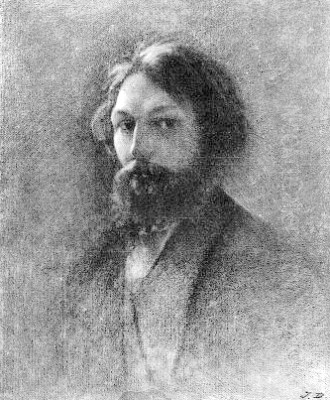
Jules Dupré stands as one of the most significant figures in 19th-century French landscape painting. Born in Nantes on April 5, 1811, and passing away in L'Isle-Adam on October 6, 1889, his life spanned a period of profound transformation in the art world. Dupré was not merely a participant but a key instigator of change, recognized as a principal founder and member of the influential Barbizon School. His work masterfully bridged the gap between the fading ideals of Romanticism and the burgeoning spirit of Realism, leaving an indelible mark on the depiction of nature and influencing generations of artists to come, including the Impressionists. His canvases capture the soul of the French countryside, the dramatic interplay of light and shadow, and the raw power of the natural world.
Early Life and Artistic Awakening
Jules Dupré's artistic journey began not in a formal academy, but amidst the practical craft of porcelain production. His father managed a porcelain factory, first in Nantes and later in Parmain, near L'Isle-Adam. It was here, surrounded by the processes of decoration and design, that the young Dupré received his initial artistic training. Working as an apprentice decorator from the age of twelve, he learned the fundamentals of line, form, and color application directly through hands-on experience. This early grounding in decorative arts likely instilled in him a sensitivity to surface and finish, though his true passion lay elsewhere.
Around 1829, seeking broader horizons, Dupré moved to Paris. This relocation marked a pivotal moment, immersing him in the vibrant artistic milieu of the capital. While sources mention potential studies under figures like Isidore Pils, Henri Lehmann, and Désiré-François Laugée at the École des Beaux-Arts, his development seems equally shaped by informal learning and crucial personal connections. He formed important early relationships with established painters such as Jean-Louis De Marne and Jean-Victor Bertin, artists who represented the more traditional landscape styles he would soon react against.
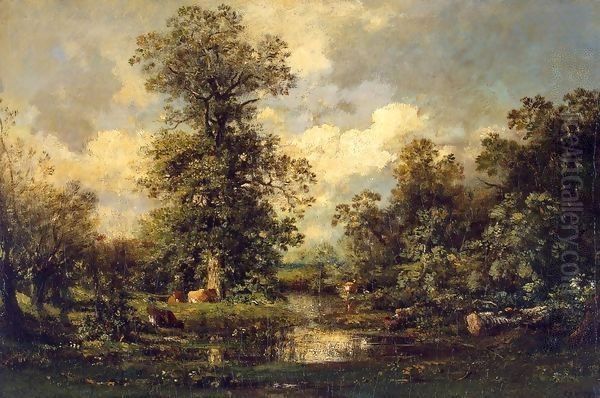
Perhaps most significantly during this formative period, Dupré befriended Louis-Nicolas Cabat, another aspiring landscape painter. Their friendship proved deeply influential, providing mutual support and artistic dialogue. They reportedly shared a studio, fostering an environment of shared exploration and growth. Through Cabat and the wider Parisian art scene, Dupré began to define his own artistic voice, moving away from purely decorative work towards the expressive potential of landscape painting. His early experiences, blending craft discipline with burgeoning artistic ambition, laid a unique foundation for his future achievements.
The Influence of England and Constable
A critical turning point in Dupré's artistic development came with his travels to England, likely occurring in the early 1830s, possibly around 1834. During this visit, he encountered the revolutionary works of the English landscape master, John Constable. Constable's approach was a revelation. Unlike the idealized, classical landscapes prevalent in French academic tradition, Constable painted the English countryside with a directness, freshness, and sensitivity to atmospheric effects that was groundbreaking.
Constable's emphasis on capturing the fleeting effects of light and weather, his use of broken color, and his commitment to painting the specific character of a place resonated deeply with Dupré. He saw in Constable's work a path towards a more truthful and emotionally resonant depiction of nature. The impact was profound and lasting. Dupré absorbed these lessons, adapting them to his own temperament and the French landscape.
Returning to France, Dupré began to integrate these newfound influences into his work. His brushwork became bolder, his palette often richer, and his attention to the nuances of light – the gleam of sun after a storm, the heavy atmosphere of an overcast day, the dramatic glow of sunset – became a hallmark of his style. This English sojourn was instrumental in steering Dupré away from neoclassical conventions and towards the more naturalistic and expressive path that would lead him to the forefront of the Barbizon School. It solidified his commitment to observing nature directly and translating its vitality onto the canvas.
The Barbizon School and the Love of Nature
Jules Dupré is inextricably linked with the Barbizon School, a loose collective of artists who, from the 1830s onwards, gathered near the village of Barbizon on the edge of the Forest of Fontainebleau. While not a formal institution, these painters shared a common desire to break free from academic constraints and paint landscapes with greater realism and emotional depth. They drew inspiration directly from nature, often sketching outdoors (en plein air) to capture immediate impressions, even if final works were completed in the studio. Key figures alongside Dupré included Théodore Rousseau, Jean-François Millet, Camille Corot, and Constant Troyon.
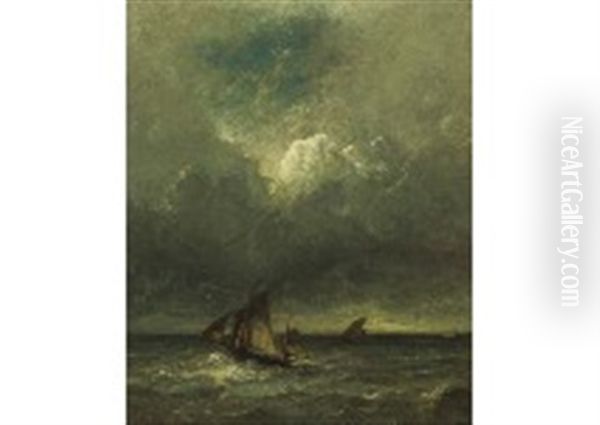
Dupré was a central and highly respected member of this group. He fully embraced the Barbizon ethos, finding profound inspiration in the French countryside. While the Forest of Fontainebleau was a frequent subject, his explorations extended further afield. He traveled extensively, seeking out diverse landscapes that resonated with his artistic sensibilities. The rugged terrain of the Pyrenees, the open expanses of the Landes region in southwestern France, and the forests near Creuse and Montmorency all provided rich material for his canvases.
His subjects often focused on the intimate corners of nature: dense forest interiors, tranquil ponds reflecting ancient oak trees, winding country roads, and the expansive skies above. He possessed a particular affinity for depicting the transitional moments of the day, especially sunset, where light and color create dramatic, often melancholic effects. Water, whether calm in a pond or turbulent in the sea, was another recurring motif, allowing him to explore reflections, movement, and the interplay of light on fluid surfaces. Dupré's deep connection to these natural settings formed the very core of his artistic output.
Artistic Style: Realism Meets Romanticism
Jules Dupré's artistic style is characterized by a compelling synthesis of Realism and Romanticism. He grounded his work in careful observation of the natural world, a hallmark of the Realist impulse driving the Barbizon School. His trees have solidity, his earth feels tangible, and his skies are based on genuine atmospheric conditions. He sought to represent the specific character of the French landscape, moving beyond generic or idealized depictions.
However, Dupré infused this realism with a powerful emotional charge drawn from the Romantic tradition. His landscapes are rarely mere topographical records; they are imbued with mood, drama, and a sense of nature's sublime power or quiet melancholy. This is particularly evident in his treatment of light and atmosphere. He excelled at capturing dramatic effects – the turbulent skies preceding a storm, the fiery intensity of a sunset bleeding across the horizon, the deep shadows of a forest interior pierced by shafts of light. His famous depictions of solitary, majestic oak trees, often silhouetted against a luminous sky or reflected in still water, carry a profound sense of permanence and quiet dignity.
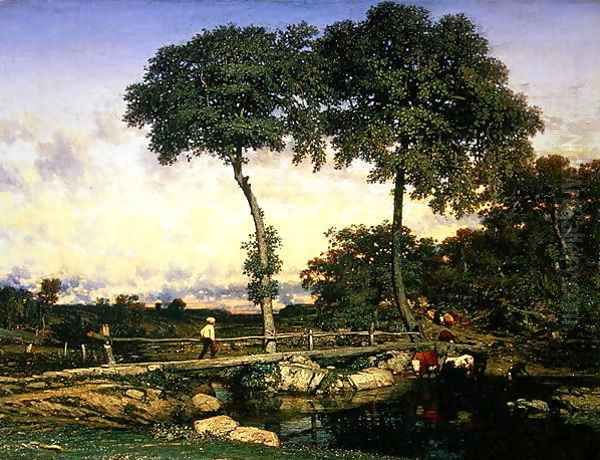
His technique supported this expressive aim. Dupré often employed rich, sometimes somber colors and a vigorous, textured brushstroke (impasto) that added physical presence and energy to the paint surface. He wasn't afraid to use strong contrasts between light and dark (chiaroscuro) to heighten the drama. Works like The Oak Trees and the Pond exemplify this blend, combining detailed rendering of the trees and water with a romantically charged, light-filled sky. His seascapes, such as The Rough Sea, capture the dynamic energy and raw power of the ocean with similar intensity. Dupré’s unique talent lay in his ability to render nature faithfully while simultaneously expressing its profound emotional impact on the human spirit.
Relationships with Contemporaries
Throughout his career, Jules Dupré maintained significant relationships with many leading artists of his time, fostering both collaboration and, occasionally, friction. His early friendship with Louis-Nicolas Cabat was foundational, providing crucial support as they navigated the Parisian art world together. As he matured, his connections within the Barbizon group became paramount.
His most significant, and complex, relationship was with Théodore Rousseau. For nearly two decades, they were inseparable friends and artistic confidants. They traveled together, sketched side-by-side, and shared studio space, profoundly influencing each other's work. Rousseau's meticulous detail may have encouraged Dupré's observational skills, while Dupré's bolder, more dramatic approach perhaps influenced Rousseau's later work. However, around 1847, a rift developed between them, often attributed to artistic differences or perhaps personal disagreements, leading to an unfortunate estrangement that lasted until Rousseau's death. Despite this break, Dupré always maintained a deep respect for Rousseau's artistry.
Dupré was also closely associated with other Barbizon giants like Jean-François Millet, known for his depictions of peasant life, and the lyrical landscape painter Jean-Baptiste-Camille Corot. He shared friendships and professional associations with Constant Troyon, noted for his animal paintings, and Alexandre-Gabriel Decamps. He collaborated with figures like Paul Huet and the marine painter Eugène Isabey on various artistic endeavors, including efforts to promote regional exhibitions that supported both local artists and emerging talents from Paris.
These interactions were not always harmonious. Dupré, alongside Cabat, Huet, Isabey, Corot, and Rousseau, participated in petitions aimed at reforming the conservative jury system of the official Paris Salon, though these efforts met with limited success initially. His network included earlier figures who influenced his youth, like Jean-Victor Bertin and Jean-Louis De Marne. This web of relationships highlights Dupré's central position within the mid-19th-century French art scene, a respected colleague and influential figure among his peers. His brother, Léon-Victor Dupré, was also a landscape painter, though less renowned.
Advocacy and Recognition
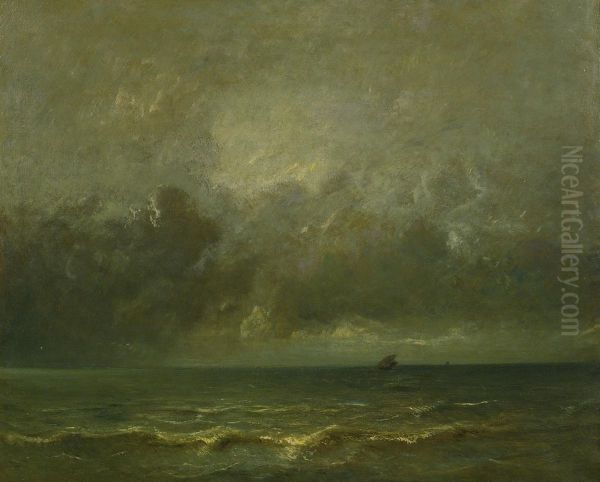
Jules Dupré was not content merely to paint; he actively engaged with the art world's structures and politics. He held strong convictions about artistic freedom and chafed under the often rigid and conservative judgment of the official Paris Salon jury. The Salon was the primary venue for artists to exhibit their work and gain recognition, but its selection process frequently favored established academic styles over newer, more innovative approaches like those emerging from Barbizon.
In response to this perceived bias, Dupré became a vocal advocate for alternative exhibition venues. His most notable action in this regard was his involvement in organizing an independent Salon exhibition in 1847. This move, undertaken with other like-minded artists, was a bold challenge to the established system and a crucial step towards greater artistic independence. While perhaps not immediately overturning the Salon's dominance, it signaled a growing desire among artists for self-determination and paved the way for later independent exhibitions, including those of the Impressionists.
Despite his sometimes oppositional stance, Dupré's talent did not go unrecognized by the establishment. His career received a significant boost early on when he won a second-class medal at the Paris Salon of 1832, just a year after his debut. A more prestigious acknowledgment came in 1849 when he was awarded the Cross of the Legion of Honour (Chevalier de la Légion d'honneur), a significant state recognition of his contribution to French art and culture. This award underscored his growing stature and the undeniable quality of his work, even as he continued to push artistic boundaries. His paintings began to enter major collections, ensuring his visibility and influence.
Later Years and Legacy
In his later years, Jules Dupré continued to paint with dedication, though perhaps with a greater sense of solitude than in his bustling Barbizon days. He spent considerable time on the Normandy coast, particularly at Cayeux-sur-Mer, where the dramatic meeting of sea and sky provided fresh inspiration. His focus shifted more towards marine subjects during this period, capturing the turbulent energy of storms, the vastness of the ocean, and the subtle play of light on water with the same intensity he brought to his forest landscapes. These late seascapes are considered among his most powerful and expressive works.
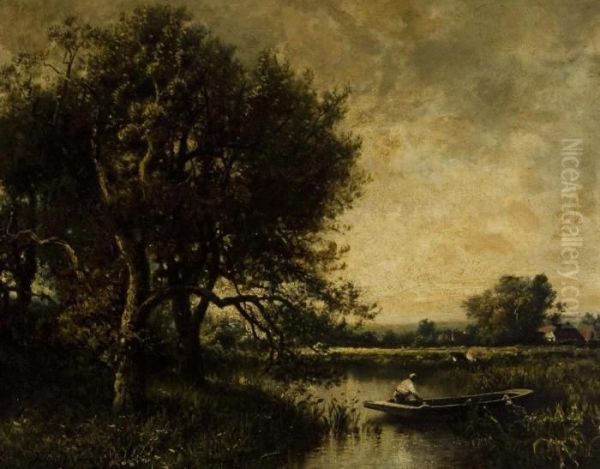
Dupré passed away in 1889 at L'Isle-Adam, the area where his family's porcelain business had been located and a place he returned to throughout his life. He left behind a significant body of work and a profound legacy. As a leading figure of the Barbizon School, he played a crucial role in establishing landscape painting as a major genre in France, elevating it from mere background scenery to a subject worthy of serious artistic exploration in its own right. His unique blend of Realist observation and Romantic sensibility created landscapes that were both truthful and deeply evocative.
His influence extended beyond his immediate circle. His emphasis on capturing the effects of light and atmosphere, heavily influenced by Constable, directly anticipated the concerns of the Impressionists. Artists like Claude Monet would later acknowledge the importance of the Barbizon painters. Vincent van Gogh, in his letters, expressed admiration for Dupré's handling of light and his powerful depiction of nature, seeing a certain avant-garde quality in his work. Today, Dupré's paintings are held in prestigious museums worldwide, including the Louvre and Musée d'Orsay in Paris, the Metropolitan Museum of Art in New York, the National Gallery in London, and many others, cementing his status as a master of 19th-century French landscape. His brother, Léon-Victor Dupré, continued the landscape tradition, though Jules remains the more celebrated figure.
Representative Works
While a comprehensive list is extensive, certain works stand out as particularly representative of Jules Dupré's style and thematic concerns:
The Oak Trees and the Pond (various versions, undated): Perhaps his most iconic theme, these paintings showcase his mastery in depicting majestic trees, reflective water, and luminous skies, blending Realism with Romantic grandeur.
The Flood Gate (c. 1855-60): A powerful example of his ability to capture the interplay of water, light, and rural architecture, often imbued with a sense of quiet drama.
Sunset over the Oise (various dates): Dupré frequently painted the area around the Oise river, and his sunset scenes are renowned for their rich color and evocative atmosphere.
Forest Landscape (various, e.g., 1840s): These works delve into the dense interiors of the woods, exploring the effects of filtered light and shadow, characteristic of the Barbizon School's focus.
The Rough Sea or Seascape (various, especially later): His marine paintings, often depicting stormy conditions off the Normandy coast, demonstrate his skill in capturing the dynamic energy and raw power of nature.
Cattle in the Woods (e.g., 1837) or Crossing the Bridge: Examples of his earlier work incorporating pastoral elements within the landscape, showing his connection to rural life.
On the Road (1856): A more tranquil scene, showcasing his ability to find beauty and painterly interest in simple, everyday countryside views.
These works, among many others, illustrate Dupré's consistent engagement with the French landscape, his sensitivity to light and atmosphere, and his unique ability to convey both the tangible reality and the emotional resonance of the natural world.
Conclusion
Jules Dupré remains a pivotal figure in the history of French art. As a driving force behind the Barbizon School, he championed a move towards greater realism and direct engagement with nature in landscape painting. His work brilliantly synthesized the detailed observation of the emerging Realist movement with the emotional depth and dramatic flair of Romanticism. His profound sensitivity to light, atmosphere, and the inherent character of the French countryside produced canvases that are both visually stunning and deeply moving. Through his art, his advocacy for artistic independence, and his influence on contemporaries and subsequent generations, including the Impressionists, Dupré secured his place as a true master whose contributions continue to be admired and studied today. His landscapes offer timeless visions of nature's power, tranquility, and enduring beauty.